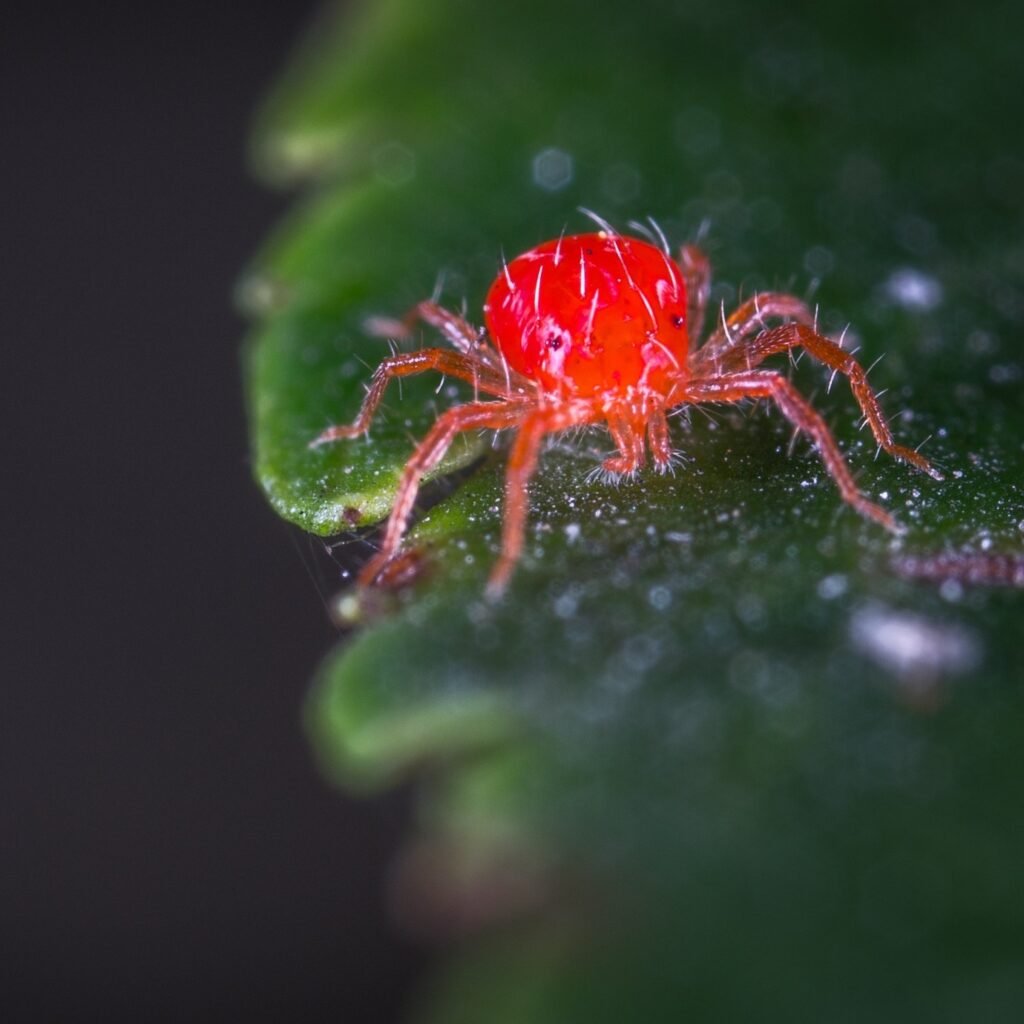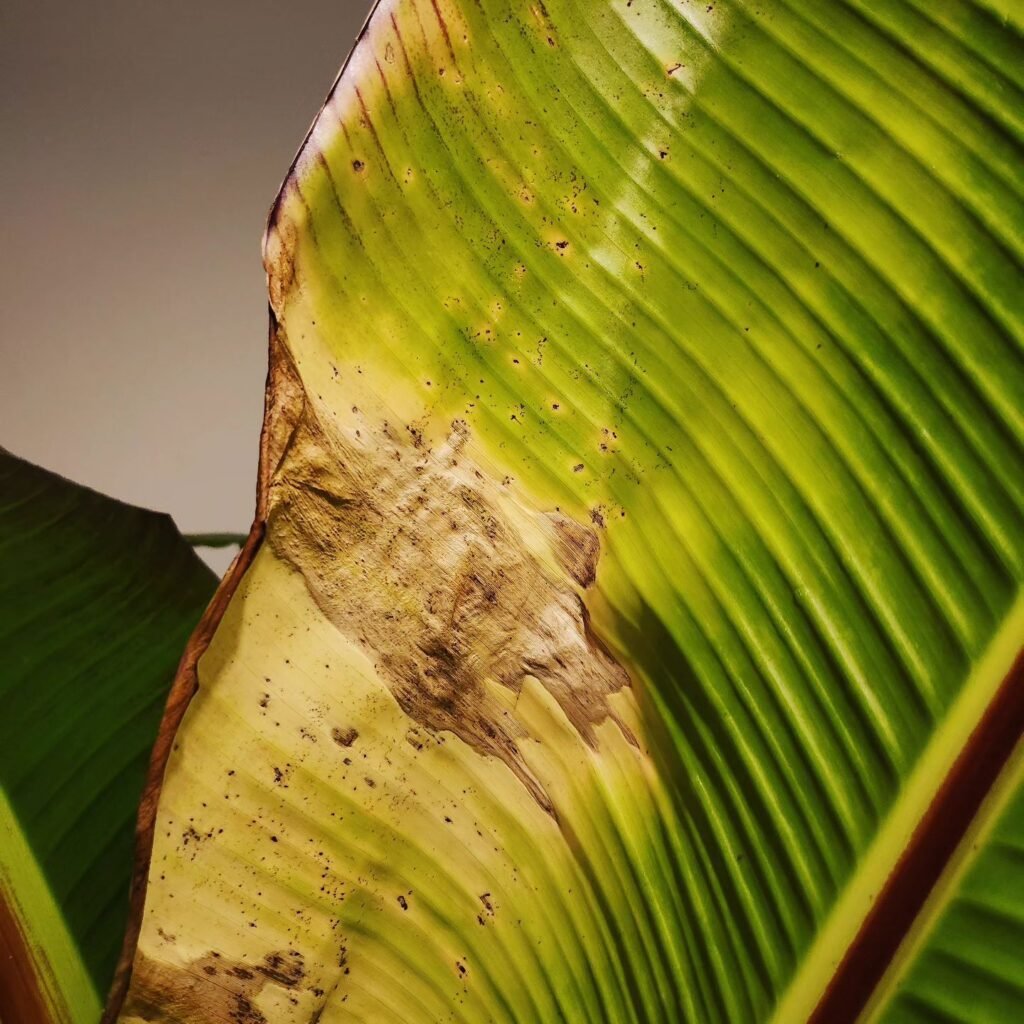In the UK’s varied climate, our cherished indoor and outdoor green spaces are sometimes marred by pests, despite our best efforts. Among these, the spider mite emerges as a formidable foe. These tiny creatures, if not promptly dealt with, can devastate our plants.
What are Spider Mites?

Spider mites, tiny pests varying in colors such as yellow, green, orange, or brown, are adept at concealing themselves on a wide array of vegetation including fruit trees, flowers, and shrubs. These creatures are particularly challenging to detect due to their small size. They feed on the sap of leaf undersides, leading to diminished photosynthesis, stunted growth, and potentially plant death.
Their preference for dry, sunny environments means certain plants are more susceptible. It’s crucial to inspect new plants thoroughly to prevent inadvertently introducing spider mites into your space.
Signs of spider mite attack include:
- Light spots appearing on leaves, visible from above over time,
- Fine webbing, initially near the leaf base,
- Deposit on leaves,
- Curling and drying of leaves and flowers,
- Drying of needles in the case of coniferous plants.
Ways to Get Rid of Spider Mites

To combat spider mites, which dislike moisture, an initial remedy involves giving affected plants a water bath while being careful not to oversaturate the root ball to prevent rot. A thorough leaf spray, using hand-held pressure sprayers, is effective. For smaller plants, a gentle shower rinse while covering the pot is advisable, with a recommendation to repeat the process. Another crucial step is repotting into nutritious soil for recovery, or for larger plants, replacing the topsoil layer. If infestations persist, specialized treatments may be necessary after pruning damaged foliage. Regular application of pest control products, especially in spring and summer, acts as a preventative measure. Although ladybugs are natural predators, they are more effective against aphids than spider mites.
Here’s a condensed guide to managing spider mites effectively:
- Moisture Method: Deter mites by watering plants thoroughly or showering smaller ones, avoiding overwatering the root area.
- Soil Refresh: Repot weak plants in nutrient-rich soil; for bigger plants, just change the top layer of soil.
- Prune and Clean: Cut away damaged foliage to prevent mite spread.
- Chemical Assistance: Use specific anti-mite treatments post-pruning for new growth protection.
- Preventive Measures: Apply treatments in spring and summer to pre-empt infestations.
- Natural Predators: Employ ladybugs for biological control, noting they’re more suited to combating aphids.
Pest Control Preparations for Spider Mites
In the UK, gardeners have access to a variety of spider mite control products from trusted brands available at garden centres and DIY stores such as B&Q and Homebase. These range from eco-friendly options, which are most effective when used at the initial stages of mite infestation, to stronger chemical solutions for severe cases. The choice extends to sprays and aerosols, tailored to different types of plants, including specific formulations for conifers and vegetables. It’s essential to observe the waiting period before consuming any treated produce to ensure safety.
Additionally, considering the predatory mites like the Californian predatory mite offers a natural and effective method to combat spider mites by targeting them at their most vulnerable stages, thus preventing damage before it becomes visible. This integrated approach, combining both preventive measures and targeted interventions, provides UK gardeners with effective strategies to protect their plants from the threat of spider mites.
For chemical treatments, protect your hands, eyes, and skin, and apply outdoors or in well-ventilated areas.
FAQ on Spider Mites and How to Deal With Them

Ever had trouble with spider mites on your plants? You’re in the right spot! I’ve gathered all the essential advice to help you spot and deal with spider mites. From spotting the first signs to effective natural remedies, I’ll guide you through keeping your plants healthy and mite-free.
Spider mites are tiny pests that infest plants, causing damage by feeding on the underside of leaves.
Look for fine webbing on plants, along with yellow or brown spots on leaves.
Yes, they can infest a wide range of indoor and outdoor plants.
They prefer warm, dry environments and are more active in summer.
Maintain higher humidity levels and inspect new plants before introducing them to your garden or home.
Natural predators like ladybugs, neem oil, and a water spray can be effective.
Yes, but they should be used as a last resort and according to the product’s instructions.
Regularly, especially during warmer months when they are most active.
Isolate the affected plant and start treatment immediately to prevent spreading.
No, they are a threat only to plants.
In the UK, spider mites commonly affect greenhouse plants like tomatoes and cucumbers, as well as ornamental plants such as roses and indoor favourites like spider plants.
Most garden centres and online gardening shops in the UK stock a range of treatments, from chemical pesticides to organic and biological solutions.

